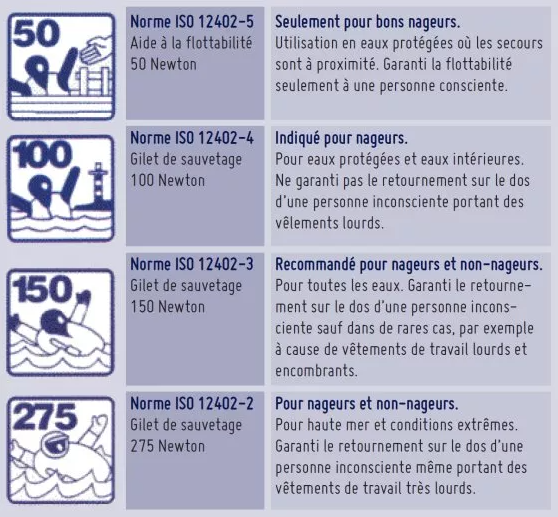Lifejacket : How to choose your lifejacket
The main functions of a lifejacket
The choice of a lifejacket depends above all on the sailing program and the use you make of it.
A lifejacket is considered personal protective equipment (PPE). If worn and used properly, it increases the chances of survival in the event of a fall into the water. It must be chosen according to various criteria such as
-
the legal standards in force in the country and for the activity practiced
-
the conditions of use
-
the morphology
The primary function of a lifejacket is to keep your head out of the water in order to keep your airways free. It will also allow you to find your way around efficiently to facilitate rescue. Your lifejacket is therefore an essential safety element at sea. It must be worn to be fully effective and increase your chances of survival in the water! Life jackets are divided into two categories.
-
An inflatable lifejacket} is a safety equipment that allows you to float on your back and offers sufficient support for your different uses at sea or in rough waters. Their buoyancy is ensured by the perforation of a bottle ofCO2 gas, more commonly known as "carbon dioxide", which instantly inflates the air tanks provided for this purpose. Wearing this system on your clothes gives you great freedom of movement, while preserving your comfort. The activation of an inflatable life jacket can be done manually or automatically according to different procedures.
-
A buoyancy aid, brace or foam vest, is a safety device that provides sufficient support in sheltered waters, but does not have enough capacity to allow for rollover. A foam vest or life jacket can also provide some protection in case of impact. On the other hand, their bulk, linked to the thickness of the foam ensuring buoyancy, can limit your movements and displacements during maneuvers.
The performance of a lifejacket depends greatly on the activity practiced. Just like any other navigation equipment, the choice of a lifejacket depends above all on the program and the use you make of it. This is why comfort and flexibility will be privileged in some cases, while robustness and buoyancy will be essential in other activities.
Below is a non-exhaustive list of activities requiring the use of an inflatable lifejacket or buoyancy aid: coastal and offshore sailing, dinghy and multi-sports, sailing clubs and schools, inflatable and semi-rigid, kitesurfing, water skiing and jet skiing, sea or river fishing, stand up paddle (SUP), canoeing and kayaking...
Which vest for my practice?
In order to understand how your lifejacket works, here are some keys to help you choose the model that best suits your activity and body type:
-
For occasional sailing
A manual release vest is preferred. This one inflates automatically when activated by the wearer. The lung can be 100 Newtons, or even 150 Newtons. The main advantage over a buoyancy aid is that it is much more compact and comfortable for the navigator. Warning: Minimum safety level. The system will not be activated if the navigator falls overboard while unconscious.
"Newtons": what buoyancy?
Good to know: 10 Newtons correspond to 1.01 kg buoyancy force.
Which activation mode?
There are 3 main types of activation for inflatable life jackets. All of them also have a manual release system.
-
With a cellulose pellet ( UML Pro Sensor system - with a window to visualize the state of the vest) which disintegrates on contact with water and releases the release system of theCO2 cylinder.)
-
With hydrostatic valve ( Hammar system) which is activated by water pressure. The principle prevents any untimely triggering, but remains more complicated to reactivate.
-
With manual release system that the wearer activates himself in case of a fall in the sea. Warning: Minimum safety level. The system will not be activated if the sailor falls overboard while unconscious.

Before embarking...
Our safety instructions before boarding (non-exhaustive list) :
-
Always make sure your equipment is working properly
-
Make sure that each person on board knows the exact location of the safety equipment
-
Make sure that everyone on board knows how to use a lifejacket
-
Ideally, wear your lifejacket before you even get on board
-
Children or anyone on board who cannot swim must wear a life jacket
Our additional accessories for lifejackets:
In addition to meeting the requirements of the regulations, each lifejacket must be equipped with the following
-
an electric light source () or chemical () attached to your lifejacket and capable of lighting up for 12 hours minimum
-
a whistle attached to your lifejacket and easily accessible
-
a for an emergency use (some inflatable life jackets, type , are provided with it)
-
it is recommended to choose a life jacket with } to increase your chances of survival during spotting
How do I care for my lifejacket?
-
Remember to rinse your lifejacket with fresh water after each use, and dry it promptly
-
Store your lifejacket in a dry place away from sunlight
-
To ensure that your lifejacket is in perfect working order, please have it checked every 2 years by a professional
Happy sailing to all!
For any question or additional information, we are at your disposal at 04.78.41.79.31.
The Nautisports. com team














